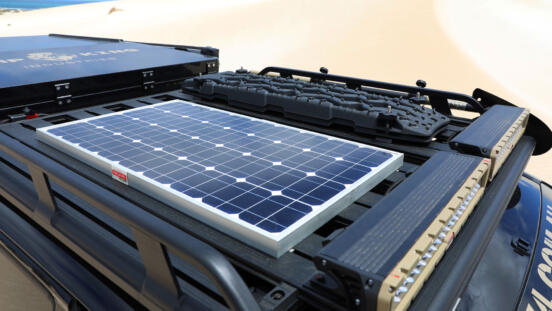
There are 4 reasons commonly toted why you “need” a snorkel. One is spot on, the rest are far too often over-simplified, overstated, so small as to be meaningless, or simply wrong. These 4 reasons are:
- Deeper water crossings
- Snorkels provide “cold” air
- Snorkels provide “clean” air
- Increased air-flow, or “ram” air
Let’s break these down one by one.
Deeper water crossing
One place a snorkel’s purpose is undisputed is deep water crossings. The factory air intake on 4WDs that don’t come fitted with a factory snorkel will usually be above the radiator grill, or inside a front wheel arch.
If you fully submerge this intake, your engine sucks in water (obviously) and not air; this can be devastating, particularly for diesel engines.
Water does not compress like air. When a piston in your engine does its compression stroke, it’s expecting to compress a mixture of air and fuel, instead, when your engine is flooded it hits a block of water that won’t compress. The engine will then seize due to “hydro-lock”.
In a best-case scenario with a petrol engine, removing the spark plugs and turning the engine over will eject enough water that it can be started again. All engine fluids will need to be replaced, and the systems cleaned, as they will be contaminated and cause corrosion/damage over time if not done.
In a worst-case scenario, the sudden forced stop of pistons will break connecting rods, which can cause a series of further damage, effectively destroying the engine. Your trip is over. Hydro-locked engines can often be rebuilt, but this can easily be $5,000 – $10,000, if not more. In the worst cases, it can be cheaper to buy a new engine.
A properly sealed snorkel will raise your intake level several feet above the factory air intake, preventing your engine from sucking in water, and allowing deeper crossings.
So the question then becomes, how deep are the bodies of water you’re crossing?
As an example, the 2024 Toyota 300 series Land Cruiser has a 700mm (27″) wading depth, which is typical of most four-wheel-drives. The 300 can do crossinsg shallower than 700mm all day without a snorkel.
Check your owner’s manual for your specific wading depth, but it will be somewhere in this neighborhood. If you’re regularly going to be exceeding this, then a snorkel is a no-brainer. That’s exactly what it’s for.
If deep water crossings aren’t a part of your off-road travels, a snorkel isn’t going to provide any benefit here. Spoiler… a foot and a half deep creek isn’t a deep water crossing.

Warranty claims
One thing that needs addressing in relation to the above is warranty, as there are some vague statements floating around concerning this.
Many third-party manufacturers state that fitting a snorkel does not void your warranty, and for the most part, this is true, but, while a snorkel shouldn’t void the warranty of anything on the rest of your vehicle, it also doesn’t extend or overwrite any of your warranty limitations.
Regardless of the fact that your 4WD can now technically cross a river 5 feet deep (double the OEM wading depth) the manufacturer’s limitations remain the same. If you perform a deep water crossing in your 300 series that exceeds the OEM specified wading depth of 700mm, and a broken seal or install fault results in water intake into the engine, that’s on you.
Saying “But I fitted a snorkel!” isn’t going to get Toyota to foot the bill.
Snorkels provide “cold” air, compared to your factory intake
Cold air will help your engine perform better than hot air, this is true. Colder air is denser, thereby containing more oxygen than the same volume of hot air. More oxygen allows you to burn more fuel, creating more power. No argument.
Back in the day, there were engines that pulled hot air from the engine bay. For decades now though, virtually all vehicles come from the factory with cold air intakes; this is piping that leads from the air filter box in the engine bay to an exterior port or scoop somewhere on the vehicle, to pull in ambient temperature air from outside.
This intake is typically either above the radiator grill or inside a front wheel well. In any case, the engine is already pulling in ambient air from outside the engine bay, the same as a snorkel will.
The counter-argument to this is sometimes that the higher elevation snorkel provides “cold” air compared to the factory intake. If you were measuring temperature compared to 6 inches from a hot, sun-baked road, sure, there would be a difference. But when comparing 3 feet above the ground where your factor intake sits compared to 6 feet about the ground for a snorkel, the difference is meaningless.
Let’s take the “elevation” argument, to start. On average, the temperature lowers by 6.5° Celsius (43° Fahrenheit) per 1,000 meters of elevation; this doesn’t even warrant the 2 seconds it would take to divide the temperature difference over the 3 feet of elevation a snorkel provides over your factory intake.
That’s also over a long temperature gradient from sea level to the mountains. In a practical setting for a vehicle, this smooth temperature gradient isn’t present. Wind, passing vehicles, etc. all stir the air creating one environment at your vehicle level.
But it’s far simpler than all that…
Take a digital thermometer out to your 4WD and measure the difference in temperature between the top of your radiator grill, and your roof. What’s the difference? I’m going to guess zero. Maybe 0.1° if you’ve got a super touchy thermometer.
This also doesn’t take into account that a snorkel is several feet of additional piping added to your intake that will either be made of steel, or black plastic, which can only add heat when in the sun, and pass that heat on to the air entering the snorkel. To be fair, this too will have an insignificant impact given that your engine will be drawing thousands of liters of air per minute, far more than a what few feet of plastic can rapidly heat, but, if you’re making performance claims, let’s acknowledge the negatives along with the positives.
All up, to say snorkels provide a meaningful increase in power, specifically by way of providing “cold” air compared to a factory cold air intake is objectively nonsense.

Clean air
This point is similar to the above, that pulling air from higher up means less dust and debris. Again, it’s pretty easy to observe that this benefit is widely overstated.
Driving down the highway, there is not a 4-foot-high miasma of dust and fog that covers your factory intake while your snorkel sits in perfectly clean air above it. Likewise for off-roading.
As you may have already experienced, if you’re traveling behind another vehicle on a dusty road, a great deal of dust definitely is thrown into the air, but again, it does not magically stop 4 feet from the ground; your whole vehicle will be covered in dust, including the snorkel.
I’m sure there is some perfect distance when traveling behind another vehicle where the dust is starting to settle, and heavier debris has already fallen to the ground, where you might be able to observe a difference between bonnet height and the snorkel, but how often are you going to be at exactly that point?
Ever got dust in your eye? That’s snorkel level.
Both a factory intake and snorkel will pull in clear air, or dust, depending on what you’re driving through. Whichever intake you have in place, this dust is captured by the filter in your airbox, so the air that reaches the engine is no “cleaner” having come via a snorkel.
As with the subject of “cold” air above, to say a snorkel provides a meaningful boost to power or efficiency by avoiding all the “dirty” air around your factory intake is nonsense.
Your air box filter will not become “dust-free” after fitting a snorkel, I assure you.

Image credit: RZCrew Europe
Increased air-flow, or “ram” air
The last common argument is that forward-facing snorkels provide increased air flow via “ram” air, that is air being forced into the snorkel by your forward movement. More air, more oxygen, more power.
Is the ram air effect real? Yep, absolutely, but, achieving the circumstances under which it creates a measurable difference is a completely different story.
To see a measurable benefit from ram air, you need to be going fast. Really fast. Somewhere this has been exhaustively researched, tested, and utilized is MotoGP, F1, and other racing.
In these settings, we only begin to see a measurable difference at around 100km/h (60mph), and even then it’s only a fraction of a percent. To see gains of 2-3% you need to be going double, or triple these speeds.
This is not driving, and certainly not off-roading; this is bleeding edge performance competition, where shaving off a fraction of a second can mean the difference between victory or loss.
Again, the “ram” air claim falls short of the promises with some pretty simple observations.
- If your factory intake is forward-facing, you already have “ram” air; but that’s effectively meaningless because…
- You are never going to achieve the speeds required during suburban driving to get a measurable benefit from ram air
- You’re also never going to achieve these speeds off-roading, obviously.
- While ram air is technically possible, the additional length and bends in the snorkel increase resistance to airflow; if we’re supposed to be measuring performance changes this needs to be acknowledged.
- If snorkels did provide as vast an increase of air intake as some imply, your engine would need a retune to utilize this; No snorkel manufacturer states that you need a custom tune for their product.
Many snorkel manufacturers themselves dismiss the ram air argument; there are plenty of snorkels that face sideward or backward for a sleeker fit, and these perform fine. No brand in its right mind would offer a backward-facing snorkel if it noticeably detracted from vehicle performance; they’d never sell a single unit.

So, do YOU need a snorkel?
If water crossings deeper than your vehicle wading depth are going to be part of your off-road travels, absolutely. That’s exactly what they’re for and you should get one to mitigate the risk of water damage to your engine.
As for the rest… “cold, clean, and ram” all combined might give you a few extra HP at higher RPM. It might do nothing. Some could cost you a few HP through increased flow restriction.
Even assuming the best-case scenario, what meaningful benefit is a 2-3 HP increase? You certainly can’t feel the difference, and it isn’t going to increase how much cargo you can carry, or tow, or how capable your vehicle is off-road.
To be clear, I’m not knocking snorkels here at all; I have one, but I’ve also done crossings deep enough to have water over my bonnet, and even floated my vehicle at times (not recommended, just an anecdote). The point is, on many vehicles, they are wasted.
If deep water isn’t in your future, there is a long list of modifications you could opt for instead of a snorkel that will give you far more appreciable benefits.
Read section again:
Deeper water crossings
Snorkels and vehicle warranty
Snorkels provide “cold” air
Snorkels provide “clean” air
Increased air-flow, or “ram” air






